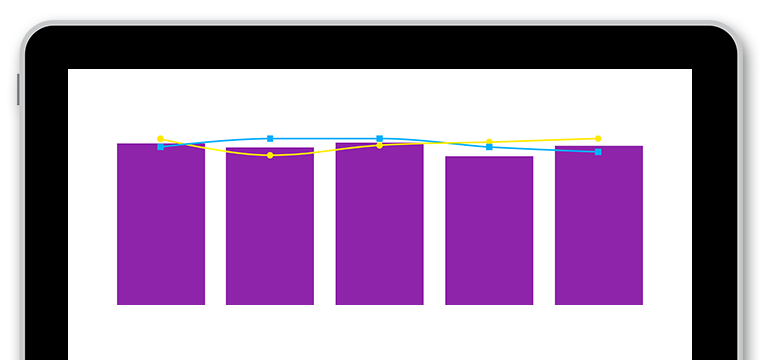OEE systems
OEE systems provide a global view of efficiency losses during the manufacturing process.
OEE stands for Overall Equipment Effectiveness . OEE systems add value at the economic, operational and organizational levels, linking three key factors of industrial production: availability, performance and quality.
Knowing the OEE allows all the company’s personnel to work with reliable information in real time, allowing immediate improvement actions to be taken at any level.
The OEE indicator of Lean Manufacturing relates the performance of the machines in comparison with an ideal or target machine, which works whenever we want it to, at maximum speed and produces good products the first time. If the production level of approved products lags behind the capacity that a machine can achieve, this is referred to as hidden production capacity. In other words, the full capacity of the machine is not being utilized for the production of defect-free products, thus resulting in losses.

OEE Systems and Industrial KPIs
Only what is measured can be managed and improved
OEE is a study that allows organizations to know, in a single ratio, the real productivity of their machines, with the objective of optimizing manufacturing processes, directly related to operating costs.
The OEE collects information on three key production indicators. To proceed with the calculation of this Lean Manufacturing indicator, it is necessary to obtain these three factors: availability, performance and quality.
As you can see in this article, the calculation of OEE productivity indicator can be done in different ways, although finally companies migrate to integral OEE, MES and MOM systems such as doeet specially designed for the calculation of OEE in real time and with 100% reliable data.
After obtaining them, they are multiplied and the result is the OEE indicator. Therefore:
OEE = availability x performance x quality
Availability
It measures the time during which production is actually taking place versus the machine’s available time.
Availability is the quotient of productive time, which includes machine start-ups, operator changeovers, breakdowns and waiting times, with the time available for a given production period.
Performance
It measures the actual production obtained against the productive capacity of the machine.
Throughput is the quotient of the division of actual production with the design productive capacity of a machine. This is affected by the micro-stops and the reduced speed of the production line.
Quality
Measures defect-free products produced versus total number of parts produced
Quality is the result of dividing good production by actual production. This is hampered by the defective parts that the machine manufactures, which forces it to repeat the work.
Having an OEE of 40% means that out of every 100 good parts the machines could have produced, they have only produced 40.
Advantages that OEE systems bring to the organization
Improves return on investment, which benefits companies that want to obtain maximum efficiency from manufacturing processes in the shortest possible time.
It reduces production losses and achieves greater competitiveness, thus helping organizations to be more competitive.
The performance of the machines increases rapidly. In addition, the OEE calculation can be applied to new machinery as well as to machines already in operation.
OEE increases process quality through the reduction of defective products. This generates enormous cost savings.
100%
Reliable data and
in real time
100% reliable and real-time data
With OEE systems such as doeet, data is obtained directly from the machines (running times, downtime and units produced), so that production records are reliable and cannot be manipulated by the operator.
The operator must only identify himself at the beginning of the shift and justify, as they occur, the reasons that have produced stoppages, low speeds or quality problems, to proceed later to their analysis by the production department.
Increased Productivity
Increased Productivity
doeet has a double functionality: to control production in real time and to know the productivity deviations (OEE: actual production vs. expected production).
To to know in real time and reliably the causes for not having achieved the expected production, allows the take prompt action to correct the resultsThe results obtained and the need to make improvements aimed at improving the quality of life of the employees involved can be shared with the personnel involved. productivity improvement.
Example of productivity improvement through OEE systems
With doeet you can achieve significant productivity gains. The data obtained from an initial production analysis allows us to make decisions to improve productivity. Once the improvements have been made, we can compare with previous data to confirm the suitability of the measures and the improvement in productivity. Let’s look at an example. In a real production process with an OEE of 56%, we applied certain improvement actions:
We reduce downtimes due to changes in mold preparation during the running time, as well as set-up times before start-up.
We improved availability from 70% to 82%.
More emphasis on initial adjustment of machines for maintenance. Preventive maintenance program. Reduction of micro-stops and speeds closer to theoretical.
We improved efficiency from 91% to 96%.
By better adjusting the machines, improving mold changes and applying effective preventive maintenance, we are able to reduce the number of nonconforming units.
We improved quality yield from 89% to 94%.
- We manufacture 18% more with the same resources (e.g. from 10,000 to 11,800 units).
- We obtain the same production with a time saving of 18%. After the OEE improvement, with 82% of the time we achieved the same units as before with 100% of the time.
| Indicator | No improvement | With improvements |
|---|---|---|
| Availability | 70 | 82 |
| Performance | 91 | 96 |
| Quality | 89 | 94 |
| OEE | 56 | 74 |
The OEE doeet system has been developed from the need of company managers and technicians to have a tool that is easy to implement, intuitive and provides all the necessary information to be able to make decisions in search of a real increase in competitiveness.
In the current situation, where sales prices are set by the market, it is essential for companies to concentrate their efforts on reducing manufacturing costs, but this is not always easy, given the difficulty of obtaining reliable information in real time.








